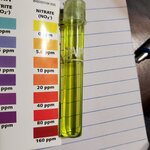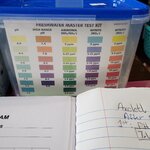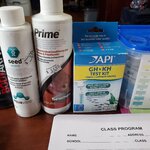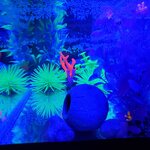Ravensight
New member
- Joined
- Aug 18, 2021
- Messages
- 12
- Reaction score
- 1
- Points
- 3
- Location
- Lansing, MI
- Country
- United States
Hello,
I am new to axolotl tanks. I'm currently trying to cycle my tank so that I can get an axolotl. So I'm not sure if I'm doing this right. My perimeters of my water after I filled my tank and dechlorinated it with prime were as follows .
Ph : 7.6 HRPH : 8.4 * too high , ammonia was 0ppm , nitrate 2 : oppm, nitrate 3: oppm, GH :8, KH : 3
I was told to put the seeding stuff in with the tank and I followed the directions on the bottle and added accordingly. I'm using an API freshwater Master test kit and an API GH and KH test kit. I waited a week and then tested it again. Below are what it is at now and my water is kind of cloudy.
Ph : 7.0 HRPH : 7.4 , ammonia was .50ppm , nitrate 2 : oppm, nitrate 3: oppm, GH :6, KH : 4
For some reason the nitrate number three was slightly green I've added the picture. Because I'm trying to do the nitrogen cycle should I be trying to fix the water at all or should I just let it continue to cycle?
I'm using a sponge filter as well. And I have a 20 long tank. I'm cycling it to get one axolotl.
Also is top fin PH decreaser okay to use it says it's for freshwater aquariums but I wasn't sure which one to get and the person at the pet store didn't know either which I don't know why they didn't know.
I have added pictures of my tank maybe I have it set up wrong? Any help is appreciated!
I am new to axolotl tanks. I'm currently trying to cycle my tank so that I can get an axolotl. So I'm not sure if I'm doing this right. My perimeters of my water after I filled my tank and dechlorinated it with prime were as follows .
Ph : 7.6 HRPH : 8.4 * too high , ammonia was 0ppm , nitrate 2 : oppm, nitrate 3: oppm, GH :8, KH : 3
I was told to put the seeding stuff in with the tank and I followed the directions on the bottle and added accordingly. I'm using an API freshwater Master test kit and an API GH and KH test kit. I waited a week and then tested it again. Below are what it is at now and my water is kind of cloudy.
Ph : 7.0 HRPH : 7.4 , ammonia was .50ppm , nitrate 2 : oppm, nitrate 3: oppm, GH :6, KH : 4
For some reason the nitrate number three was slightly green I've added the picture. Because I'm trying to do the nitrogen cycle should I be trying to fix the water at all or should I just let it continue to cycle?
I'm using a sponge filter as well. And I have a 20 long tank. I'm cycling it to get one axolotl.
Also is top fin PH decreaser okay to use it says it's for freshwater aquariums but I wasn't sure which one to get and the person at the pet store didn't know either which I don't know why they didn't know.
I have added pictures of my tank maybe I have it set up wrong? Any help is appreciated!





